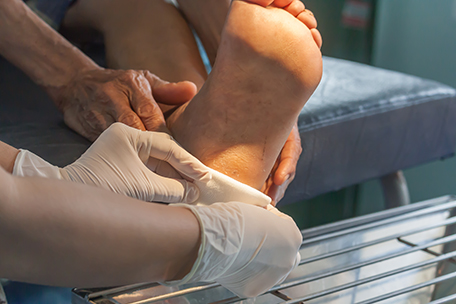Articles

Overview
Have you been in pain for quite some time due to your diabetic ulcer and are ready to get back to feeling better? An integrative therapy session with us might just be what you need for overall wellness. Here's everything you should know about the various integrative therapies available for diabetic wound care.
What is Diabetic Wound Care?
As a chronic disease, diabetes may lead to numerous symptoms in the body, depending on its severity and how well it's managed. Diabetic neuropathy is a common symptom in patients with diabetes, leading to a reduced sensation and numbness in the feet. Injuries to the foot in patients with diabetes frequently do not heal, leading to the development of diabetic ulcers or sores.
An integrative approach to diabetic wound care utilizes non-narcotic and minimally to non-invasive therapies that alleviate a patient's pain and kickstart the body's innate healing systems. Common examples of integrative approaches to diabetic wound care include:
- red and blue low-level laser therapy (LLLT) — helps promote tissue regeneration
- homeopathy
- biofeedback
- herbal topical applications such as bee wax and pollen — reduce the time diabetic ulcers take to heal
- hyperbaric oxygen therapy
Seeking Treatment for Diabetic Wound Care
There are multiple benefits to undergoing integrative therapies for diabetic wound care management. As we've already mentioned, they do not require medications and tend to be non-invasive procedures that can sometimes provide instant pain relief. They also work fairly quickly and enable patients to return to their daily activities and improve their quality of life. Certain integrative mind-body therapies such as yoga and tai chi can help promote blood flow to the feet and reduce the chance of developing diabetic ulcers.
What to Expect During a Diabetic Wound Care Session
If you've never had an integrative therapy for diabetic wound care, you might wonder what to expect during your first appointment. A trained physician at Stone Oak Womens Center will begin by asking a series of questions to determine your current health, including all symptoms you may be experiencing due to diabetes. From there, they may prescribe one or several different forms of therapy depending on your lifestyle needs and severity of symptoms.
Some therapies such as hyperbaric oxygen therapy may take longer than others and require multiple appointments—a typical session can be up to two hours in length. During the actual appointment, you'll lay on a comfortable bed inside an enclosed chamber, which will be completely filled with oxygen. Blood that's rich in oxygen can promote quicker healing of the damaged tissue. This is not a painful process, and most patients report an alleviation in symptoms after several weeks.
Effective diabetic wound care requires an accurate evaluation and prompt care using safe, effective integrative techniques.
For more information about integrative approaches to diabetic wound care, contact Stone Oak Womens Center at (210) 614-2229.
- ADD/ADHD
- Allergies
- Anxiety
- Autoimmune Disorder Therapies
- Ayurveda
- Back and Neck Pain
- Bioidentical Hormone Therapy
- Bipolar Disorder
- Body Movement Therapies
- Broad Spectrum Integrated Cancer Therapy
- Chiropractic Manipulation
- Chronic Fatigue
- Chronic Fatigue Syndrome
- Chronic Pain Management
- Concussion – TBI
- Crohn’s, Celiac’s, and Ulcerative Colitis
- Deep Breathing Therapy
- Detoxification
- Dietary Supplements
- Diabetic Wound Care
- Electromagnetic Therapy
- Exosomes
- External Energy Therapy
- Female Hormone Imbalance
- Fibromyalgia
- Functional Medicine
- Functional Medicine Cancer Support
- Generalized Anxiety Disorder Therapies
- Genetic Testing and Interpretation
- Herbal Medicine
- Homeopathy
- Integrated Cancer Symptom Management
- Integrated Fibromyalgia Therapy
- Integrative Medicine
- Integrated Pain Management Therapies
- Integrated Physical Therapy
- IV Nutrition
- Joint Pain
- Laser Therapy
- Learning Disabilities
- Lithotherapy
- Male Hormone Imbalance
- Massage Therapy
- Meditation
- Menopause
- Mesotherapy
- Micro-Fragmented Adipose Injection
- Migraines
- Music Therapy
- Naturopathy
- Neuropathy
- Nutrition and Diet
- Osteopathic Manipulation
- Physical Therapy
- Phytotherapy
- PMS
- PTSD
- Reiki
- Rheumatoid and Psoriatic Arthritis
- Sports Injuries
- Traditional Chinese Medicine
- Type 2 Diabetes
- Vertigo, Dizziness, and Balance Disorders
Stone Oak Womens Center
540 Oak Centre Drive, Ste 280,
San Antonio, TX 78258
